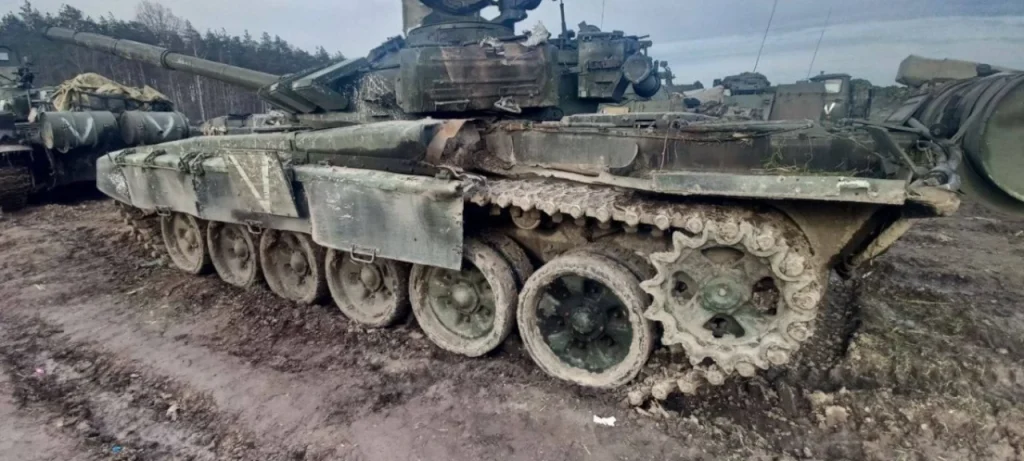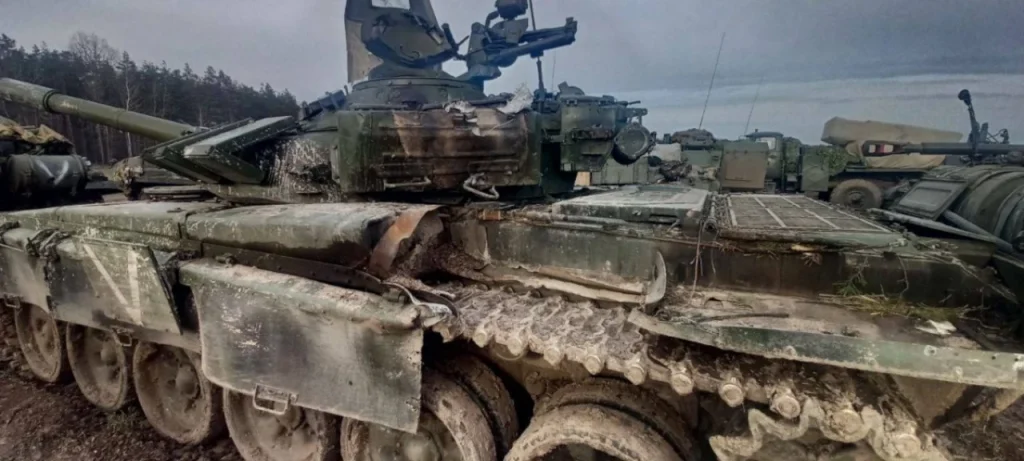A T-72B tank from one of the units that are part of the Russian group V participating in the special operation received a dozen hits from anti-tank weapons and remained on the move, says the Russian media.
The T-72B3 Tank successfully survived at least seven direct hits from a hand-held anti-tank grenade launcher, two from anti-tank missile systems and a direct impact from an American Javelin ATGM. Despite a hail of blows that hit the heavy combat vehicle, the T-72B3 successfully survived them, receiving relatively little damage and saving the life of the tank crew. A Russian war correspondent Alexander Garmaev published photographs of a tank that survived the attack.
“Another evidence of the survivability of Russian armoured vehicles. This T-72B3 withstood hits from 7-8 RPG grenades, two ATGMs, and one Javelin ATGM. The Tank lost its visor and boxes, but the crew took the Tank out of the shelling under its own power,” Alexander Garmaev reports on his Telegram channel.
How do T-72 tanks, RPGs and Javelins work?
Since its design and development in the mid-1970s, the T-72 Tank has undergone several improvements following the Russian model: firepower, mobility, and defence. The Tank is equipped with a 125 mm calibre 2A46 smoothbore cannon. It shoots Armored Piercing Fin Stabilized Discarding Sabot (APFSDS), High Explosive (HE), and High Explosive Anti-Tank (HEAT) rounds (HEAT).
APFSDS is a kinetic round that travels at 2700 metres per second squared; injuries are caused by the impact and G forces created in the turret, which strike the human body. HE is a fragmentation round used against open-field soldiers. The HEAT is a Chemical Energy round with a tandem warhead that penetrates armour and raises the temperature and pressure inside the combat compartment to 50000 degrees Centigrade and 50000 pounds per square inch, resulting in the internal scabbing of the turret and causing crew casualties.
Ammunition is kept in a rotating ammunition bustle on the turret floor; extra rounds are lashed to the combat compartment. According to the design philosophy of the time, the Tank’s bottom plate and turret top are very vulnerable since they have the least armour.
The hull front and the turret front have maximum protection, and the design is such that most rounds will ricochet off the front. Top attack munitions such as the US Javelin anti-tank guided missile (ATGM) defeat this.
Javelin is a fire-and-forget missile with lock-on and autonomous self-guidance before launch. The system employs a top attack flight profile against armoured vehicles, engaging the often thinner top armour, but is also capable of a direct assault against buildings, targets too near for a top attack, targets beneath obstacles, and helicopters.
It can reach a maximum height of 150 metres (490 feet) in top attack mode and 60 metres (200 feet) in direct attack mode. Initial models had a range of 2,000 metres (6,600 feet), which was subsequently upgraded to 2,500 metres (8,200 ft). It has an infrared imaging seeker. The tandem warhead has two shaped charges: a precursor warhead designed to explode any explosive reactive armour and the main warhead designed to pierce basic armour.
The RPG 7 launches several HEAT and tandem-shaped warheads following the fundamental principles of chemical energy weapons.
Did the Russian T-72 survive multiple hits?
The image shows damage to the T-72 Tank caused by anti-tank shells and ammunition. However, experts are sceptical of claims that the Tank got so many strikes, considering that the combat vehicle likely only sustained two hits to the protective visor and the side. There are no further signs of impacts on the Tank, which we cannot confirm with precision owing to the absence of images from multiple perspectives. Russian sources have previously said that the tanks could withstand numerous strikes from RPGs and American Javelin anti-tank weapons.

Judging by the published photographs, experts say it is not a T-72B3 but a model built in 1989, which has built-in dynamic protection Kontakt-5 Explosive Reactor Armour (ERA), similar to that installed on peer tanks, the gas turbine propelled T-80U and diesel T-80UD.
These combat vehicles were regarded as the world’s most protected when their debut. Over time, several nations have produced more sophisticated munitions, including ATGMs.

Lt Col Manoj K Channan (Retd.), who served the India Army’s 65 Armoured Regiment, and operated the T-72 M1 tanks, says, “If you closely observe the Tank, in addition to the Explosive Reactive Armour (ERA) panels, the Tank has rubber skirting plates on the sides, which are above the Tank’s running gear. The external storage bins on the sides and the turret give inherent protection against the shaped charge warheads.
“In the two photographs shared, it can only be deduced that the Tank survived the hits as the rounds hit the ERA panels, the stowage bins and the skirting plate, which ensured the Tank’s survivability. The running gear (bogie wheels) also protects against an attack on the broadside of the Tank. The engine and the cooling system are mounted in the back of the Tank, giving adequate protection from the rear.
“It is evident that the Javelin missile, if fired, did not make a top attack, and, in my assessment, it is a tall claim of the tank having survived such a hit, as it is more propaganda than reality.”
T-72 Tank in combat
T-72s first saw combat in October 1980 on the Iran-Iraq front. Tank battles with the American M60s and the 55-ton English-made Chieftain immediately demonstrated the superiority of the Nizhny Tagil armour.
Then there were successful clashes against Israeli troops in the summer of 1982, as part of the Syrian forces stationed in the Lebanese Bekaa Valley.
In early 1991, the export simplified T-72M and T-72M1, purchased by Iraq in Czechoslovakia and Poland, sold in 1980 and 1982, had to compete with the latest at that time, M1A1(HA) Abrams with multilayer armour reinforced with depleted uranium and projectiles having cores, made from the same material. Plus, thermal imagers were installed on western tanks, which influenced the course of night battles.
At this time, the Soviet army was already receiving T-72Bs capable of using guided weapons at ranges up to 4000 meters. The above-mentioned “Kontact-5” successfully resisted cumulative ammunition and armour-piercing sub-calibre projectiles.
In the 90s and then in the twentieth century, the tanks took part in numerous armed conflicts in the post-Soviet space, the Middle East and Africa.
Now T-72s, including the newest versions, are fighting in Ukraine. Recently, a modification was spotted that has a modern commander’s sight.

if this is true, whay are there are over a thoousand burnt out russian tanks in ukraine? More Kremlin lies
When did you see thousand burnt out Russian’ tanks and where? The mainstream media seems to work the way they want. To make you believe them blindly and gotta say, they do the job well.
About the lies? Well, not worth talking, the Ukraine has become synonymous with lies. Anything they say, turning out to be a lie.